Skin Tags Removal
Discover the Best Methods for Skin Tags Removal
Are you tired of those pesky skin tags causing discomfort or affecting your self-confidence? You’re not alone! Millions of people experience skin tags and are looking for the best methods to remove them. In this blog post, we delve into the world of skin tags removal, exploring medical procedures, over-the-counter products, and natural home remedies. Get ready to discover the most effective ways to say goodbye to skin tags for good!
Key Takeaways
- Safe and effective medical procedures, home remedies, and over-the-counter products are available for skin tag removal.
- Professional advice should be sought to reduce the risk of scarring & infection while detecting any potential skin cancer early.
- Adopting safe removal techniques as advised by healthcare professionals ensures successful outcomes with minimal risks.
Understanding Skin Tags
Skin tags are small, benign, and harmless growths made of collagen and blood vessels that often appear on the surrounding skin. They’re commonly found in areas where skin rubs against itself, such as skin folds in the neck, armpits, groin, and eyelids. Developing skin tags is a common occurrence and usually not a cause for concern.
Most skin tags are painless and don’t cause any issues, but they can become irritated or bleed if they frequently come into contact with clothing or jewelry. Certain factors, such as skin friction and some health conditions, contribute to the development of skin tags.
Although not medically necessary, many people seek skin tag removal for cosmetic reasons or to alleviate discomfort. A variety of effective treatments are available, including medical procedures, at-home remedies, and over-the-counter products. The subsequent discussions will focus on the optimal methods for safe and effective skin tag removal.
Medical Procedures for Skin Tag Removal
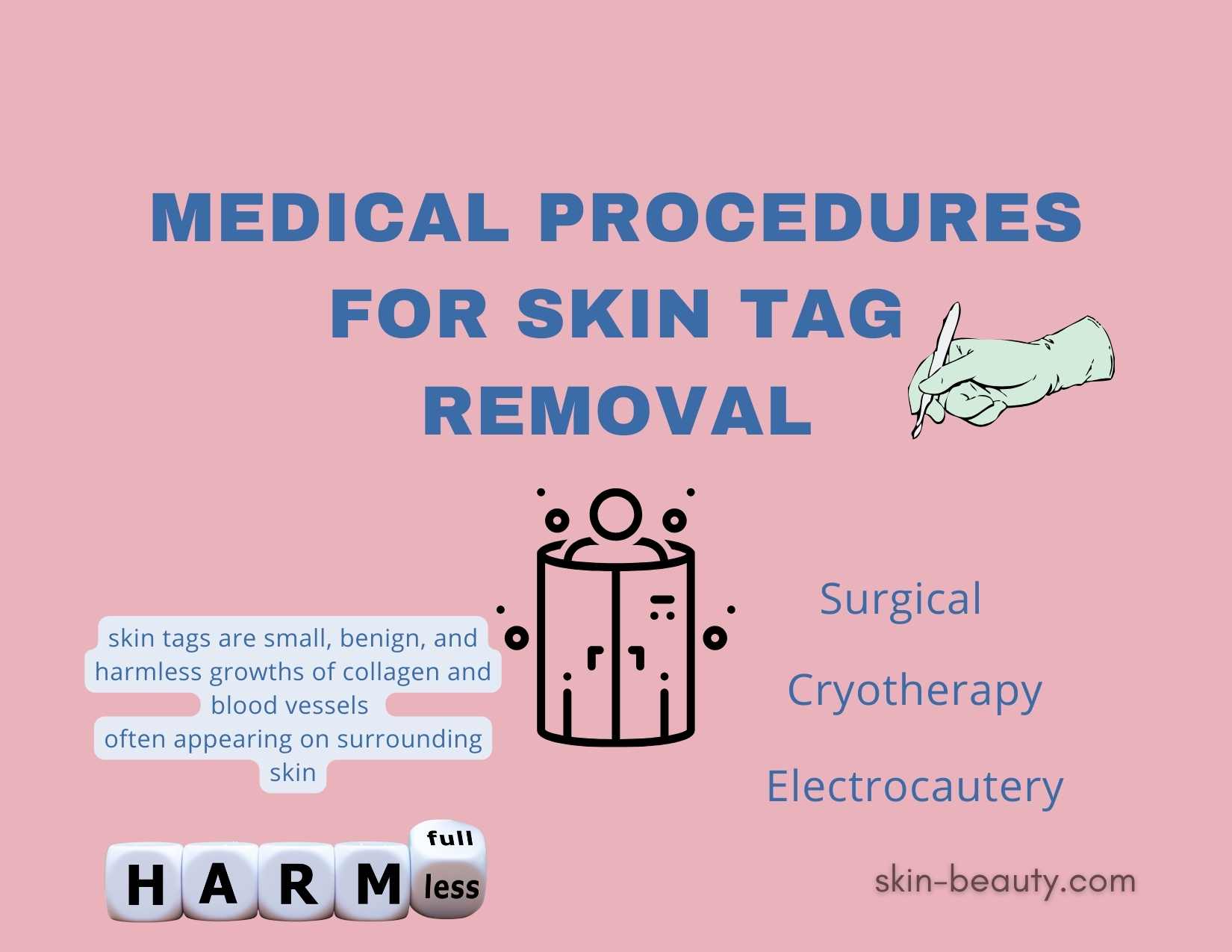
When it comes to professional skin tag removal, three options stand out: cryotherapy, surgical excision, and electrocautery. These safe and effective techniques are performed by healthcare professionals, ensuring optimal results.
We will thoroughly examine each method, highlighting how they contribute to skin tag elimination.
Cryotherapy
Cryotherapy is a beneficial medical procedure that uses liquid nitrogen to effectively remove unwanted skin tissue, such as skin tags. During this treatment, an extremely cold substance is applied to the skin tag, causing it to freeze and destroy the growth. The success rate of skin tag removal using cryotherapy is between 75% and 99%, making it a highly reliable option.
The process is simple and comfortable, with the treated area usually healing within 7 to 10 days without any scarring. Nonetheless, for safety reasons, it is highly recommended to have a doctor diagnose and remove skin tags in a medical environment.
Surgical Excision
Surgical excision is another effective technique for skin tag removal. In this procedure, a healthcare professional:
- Cuts off the skin tag using a scalpel or surgical scissors.
- The procedure is quick and efficient, typically taking around 10 to 20 minutes.
- Anesthesia is often used during the process, depending on the size and location of the skin tags.
Dissolvable stitches may be used in some cases, which conveniently dissolve in 7 to 10 days, eliminating the need for removal. Despite surgical excision’s popularity, it is essential that a healthcare provider carries out the procedure to guarantee safety and efficacy.
Electrocautery
Electrocautery is a skin tag removal method that employs an electric current to efficiently burn off the growth, minimizing bleeding and scarring. The procedure is straightforward and effective, allowing for quick and precise removal of skin tags.
One of the advantages of electrocautery is that it controls bleeding and excises tissue effectively, making it a secure method with minimal risk of scarring or side effects. However, electrocautery cannot be performed near the patient’s eyes.
The recovery time after skin tag removal through electrocautery is usually short, with the wound healing and discomfort subsiding within 5-10 days.
Over-the-Counter Products for Skin Tag Removal
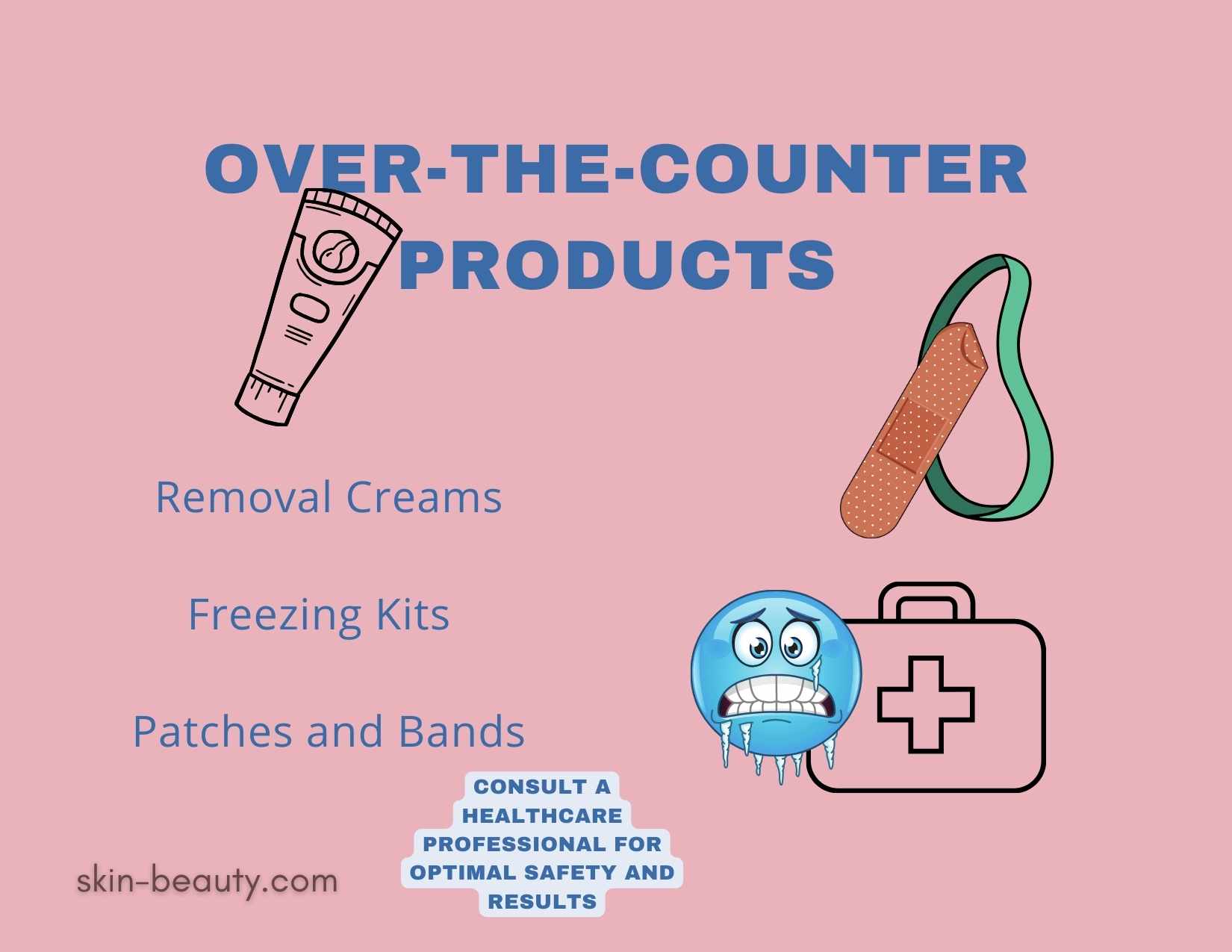
Although medical procedures are highly recommended for skin tag removal, over-the-counter products can also be used at home for those seeking to have their skin tags treated. Removal creams, freezing kits, and patches or bands are available for those seeking a more convenient and affordable option. Nonetheless, keep in mind that medical removal is usually more efficacious and safer.
We will investigate each over-the-counter product and its efficacy in eliminating skin tags.
Removal Creams
Removal creams can be an effective solution for treating skin tags. Here’s how to use them:
- Clean the skin with an alcohol wipe.
- File down the tag to maximize skin absorption.
- Apply the removal cream to the skin tag.
- Follow the instructions on the product for how long to leave it on.
- Skin tags usually fall off within 2-3 weeks after using removal creams.
Nonetheless, when using skin tag removal creams containing salicylic acid and tea tree oil, caution is advised due to potential skin irritation. Always follow the instructions carefully and consult a healthcare professional if you experience any adverse reactions.
Freezing Kits
Home freezing kits for skin tag removal contain a cryogenic solution or applicator that is applied directly to the skin tag, allowing for the freezing process to kill the cells in the tag, leading to its removal. These kits can be effective, but it’s crucial to follow the instructions and apply petroleum jelly to the surrounding area beforehand to protect the skin.
Despite some positive effects of home freezing kits like reducing skin tag size, preventing scarring, and speedy treatment, bear in mind that professional cryotherapy presents a safer alternative. Always consult a healthcare professional if you experience any adverse reactions when using home freezing kits.
Patches and Bands
Patches and bands for skin tag removal can be helpful but may not be as effective as medical removal. These devices work by cutting off the blood supply to the base of the skin tag, resulting in it falling off, or by containing medication that leads to the tag coming off.
Yet, Dr. Mokaya advocates for skin tag removal in a medical setting to destroy unwanted skin tissue, given that over-the-counter removal devices, including removal patches, lack FDA regulation and may prove ineffective. It’s always best to consult a healthcare professional for optimal safety and results.
Natural Home Remedies for Skin Tag Removal
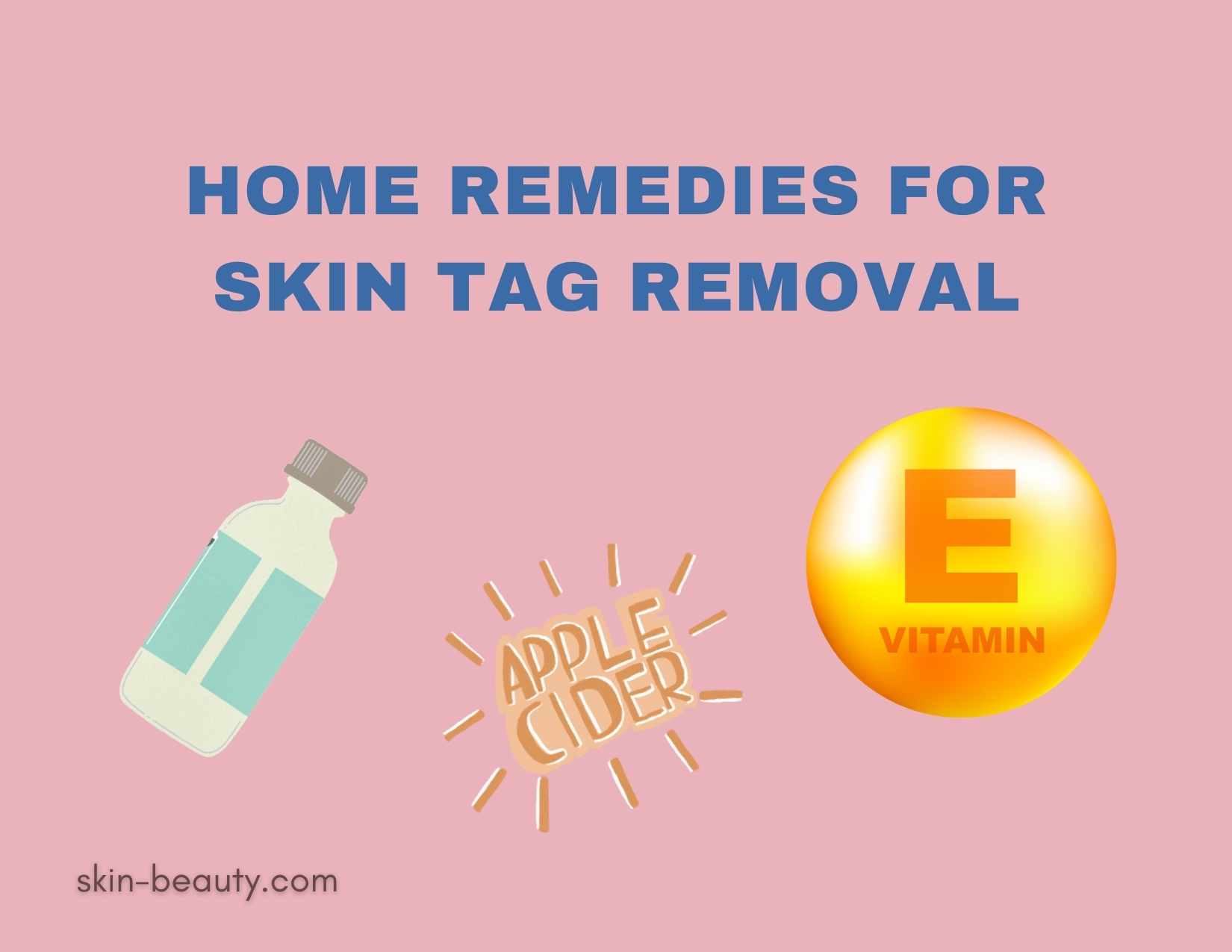
For those who prefer a more natural approach, apple cider vinegar, tea tree oil, and vitamin E can be used to remove skin tags. However, it’s crucial to exercise caution and follow proper techniques to avoid skin irritation or adverse reactions.
We will scrutinize each of these natural remedies, highlighting safe usage practices.
Apple Cider Vinegar
Apple cider vinegar is a versatile liquid that can effectively remove skin tags by breaking down the tissue surrounding the growth. To use this remedy, follow these steps:
- Soak a cotton ball in apple cider vinegar.
- Place the soaked cotton ball on the skin tag.
- Secure it with a bandage for 10 to 15 minutes.
- Repeat this process two or three times per day until the tag falls off.
Nonetheless, caution is advised when applying apple cider vinegar near the eyes or on sensitive skin. Always consult a healthcare professional if you experience any adverse reactions when using apple cider vinegar for skin tag removal.
Tea Tree Oil
Tea tree oil is a popular natural remedy for various skin conditions, including skin tags. To use tea tree oil effectively, follow these steps:
- Dilute tea tree oil with a carrier oil, such as coconut oil.
- Apply the diluted tea tree oil to the skin tag using a Q-tip.
- Leave a bandage on the skin tag overnight for several days.
- Avoid using tea tree oil on sensitive skin or near the eyes.
Adhering to correct techniques and precautions when using tea tree oil is vital to reduce the risk of skin irritation or adverse reactions. Consult a healthcare professional if you experience any issues when using tea tree oil for skin tag removal.
Vitamin E
Vitamin Eis a powerful antioxidant that can be applied directly to the skin tag and surrounding skin until it falls off. This remedy may help reduce skin irritation or an allergic reaction.
Prior to trying any natural home remedy for skin tag removal, consulting a healthcare professional is crucial to guarantee the safety and efficacy of these treatments.
Risks and Precautions in Skin Tag Removal
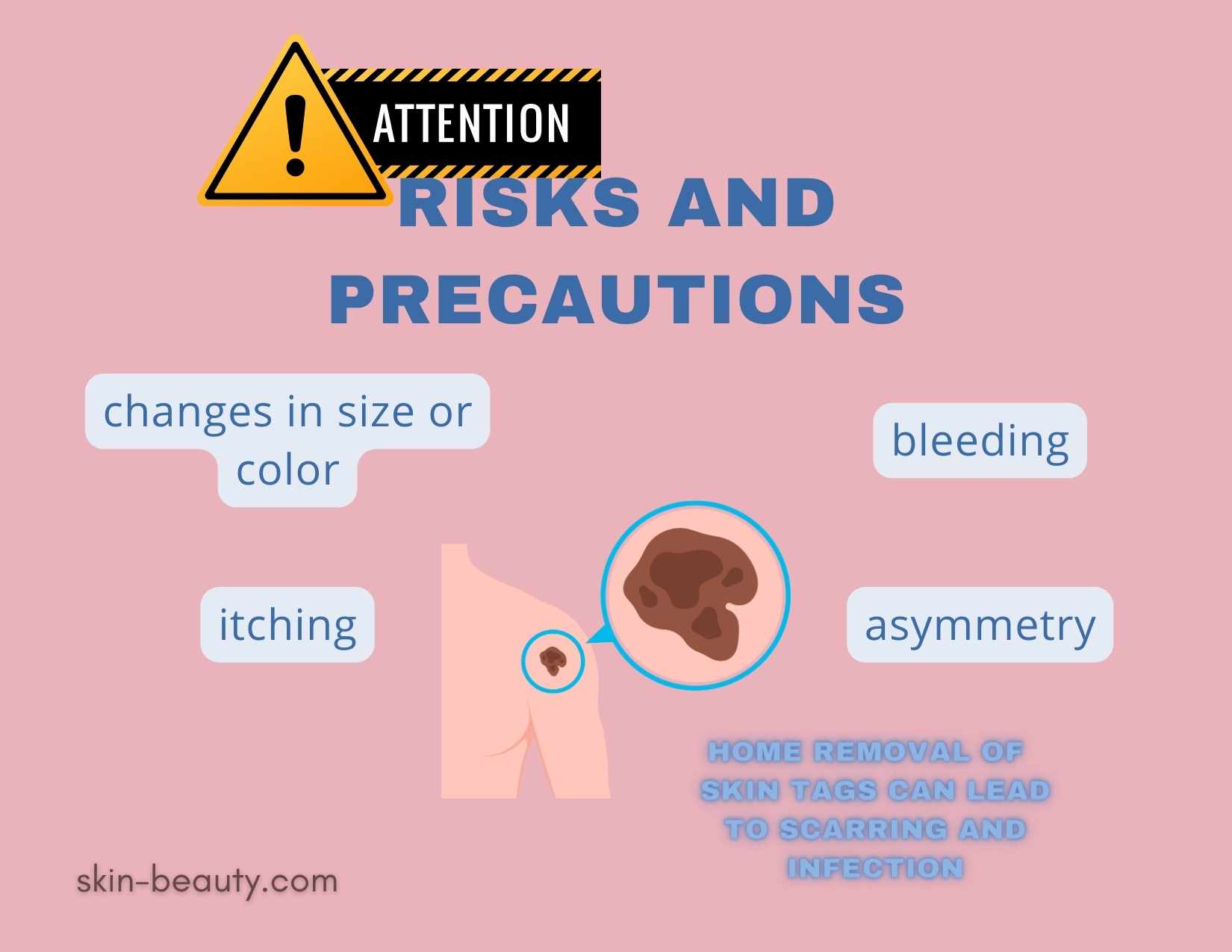
While removing skin tags at home can be tempting, it’s important to consider the risks and precautions involved. Self-removal can lead to scarring, infection, and hinder skin cancer detection.
Adherence to safe removal techniques and seeking professional assistance when necessary can mitigate these risks and guarantee optimal outcomes.
Scarring and Infection
Attempting to remove skin tags at home can lead to scarring and infection, which can be avoided by seeking professional help. For instance, if you choose to cut or clip off a skin tag at home, you run the risk of causing significant bleeding, especially if not done carefully.
To avert scarring and infection, it is advised to consult a healthcare professional to diagnose skin tags before attempting any at-home skin tag removal methods, especially if you develop skin tags frequently. They can provide expert advice and ensure the safest and most effective way to treat skin tags.
Skin Cancer Detection
Self-removal of skin tags may cause you to miss signs of skin cancer, making it essential to consult a healthcare professional for proper evaluation and diagnosis. Skin cancer can sometimes be mistaken for skin tags, and certain signs, such as:
- changes in size or color
- itching
- bleeding
- asymmetry
Skin lesions may indicate skin cancer.
Professional assistance and dermatologist evaluation of any skin growths can guarantee accurate diagnosis and treatment, possibly preventing misdiagnosis or overlooking potentially cancerous lesions.
Safe Removal Techniques
If you decide to attempt skin tag removal at home, follow proper techniques and precautions to minimize risks. Always consult a healthcare professional before trying any home remedies, especially if the skin tag is located around the eyes or genitals or if it is bleeding, infected, or changing.
Following healthcare professionals’ advice and adhering to instructions provided with over-the-counter products or home remedies can mitigate risks and guarantee the best possible outcome for skin tag removal.
When to Seek Professional Help
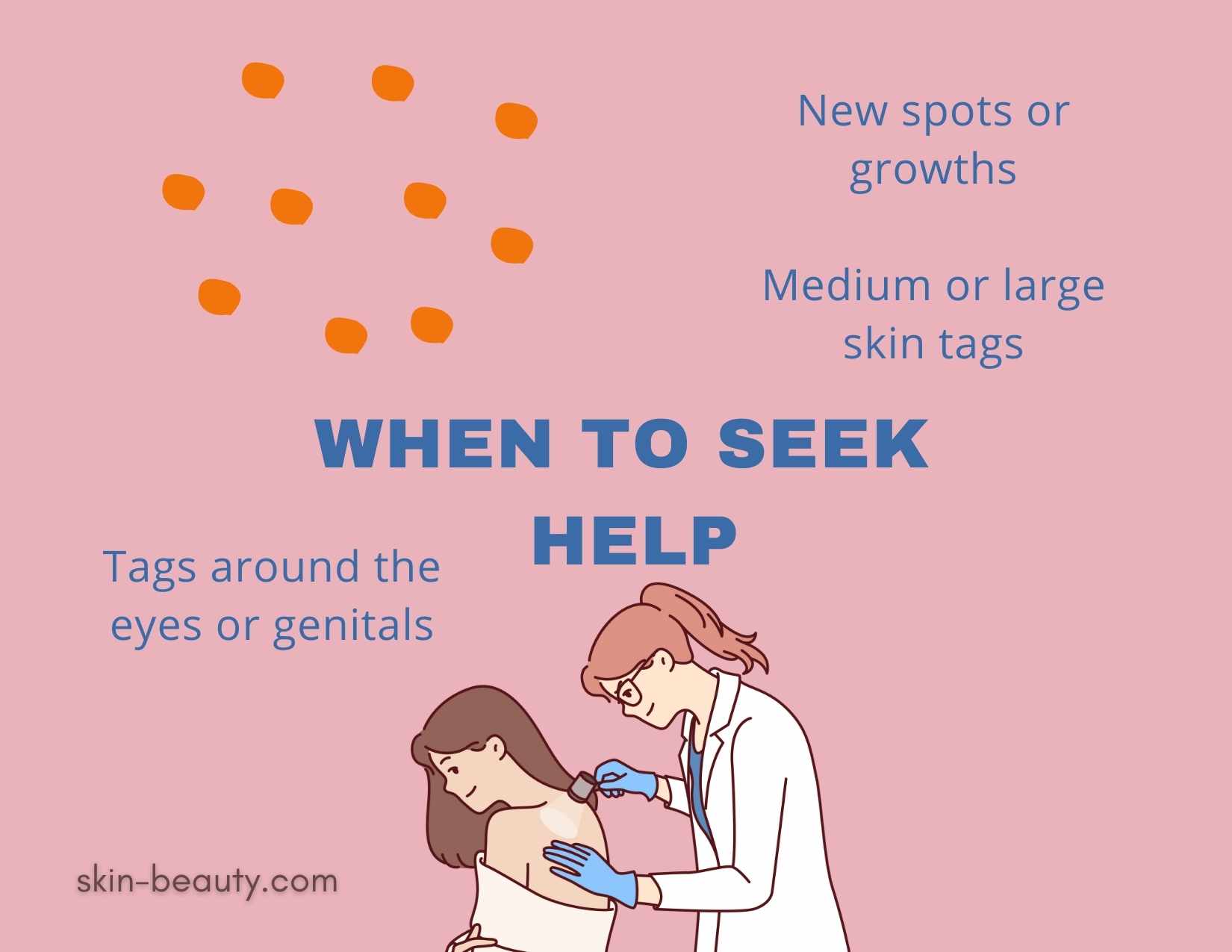
Consulting a healthcare professional is essential in the following cases:
- New spots or growths
- Medium or large skin tags
- Skin tags around the eyes or genitals
- Bleeding, infected, or changing skin tags
Seeking professional help not only ensures proper diagnosis and treatment but also helps you avoid any potential complications that may arise from self-removal.
Seeking experienced medical assistance is crucial for skin tag removal. This is especially true if the tag is large, in a sensitive area or causing pain. By seeking professional help, you can achieve the best results while minimizing the risks associated with at-home skin tag removal.
Summary
In conclusion, skin tag removal can be achieved through various methods, including medical procedures, over-the-counter products, and natural home remedies. While at-home options may seem convenient and affordable, it’s crucial to be cautious and follow proper techniques to minimize risks. Consulting a healthcare professional can ensure proper diagnosis, treatment, and the best possible outcome for skin tag removal. Now that you’re equipped with the knowledge of the best skin tag removal methods, you can confidently take the next step toward smoother, healthier skin.
Frequently Asked Questions
Can you safely remove skin tags yourself?
Although it has risks, it is possible to safely remove skin tags yourself at home. To minimize the risk of bleeding, infection or scarring, however, it's best to consult with a professional.
What removes skin tags instantly?
Excision with a blade is the quickest and most effective way to remove skin tags instantly. Cryotherapy is also an option, although it's not as instantaneous.
Why am I getting skin tags?
Skin tags are harmless, non-cancerous growths that can form as we age or when the skin rubs against itself. They're most common in people living with overweight and obesity who have folds of skin, or if you have diabetes, metabolic syndrome, or a blood relative has skin tags. However, if their appearance bothers you, there are removal procedures available.
How to remove skin tags?
To safely remove skin tags, a dermatologist can use cryotherapy, electrocautery, or surgical scissors/scalpel to freeze, burn, or cut off the growth. Anesthetic is also typically used to minimize discomfort.
Can skin tags grow back after removal?
It is unlikely that skin tags will grow back after removal, however you may develop new skin tags in the same area or elsewhere on your body.
Recent Posts
-
Hyaluronic Acid Injections
Hyaluronic Acid Injections: What to Know & Non-Invasive Alternatives That Actually Work In the p …Jun 17th 2025 -
Kojic Acid Creams
My Kojic Acid Journey: How One Ingredient Transformed My Skin (And the Best Kojic Acid Creams to Try …Jun 11th 2025 -
LightStim vs. Omnilux
LightStim vs. Omnilux: My Real LED Skincare Results & Which One I Recommend LED light therapy&nb …Jun 3rd 2025




